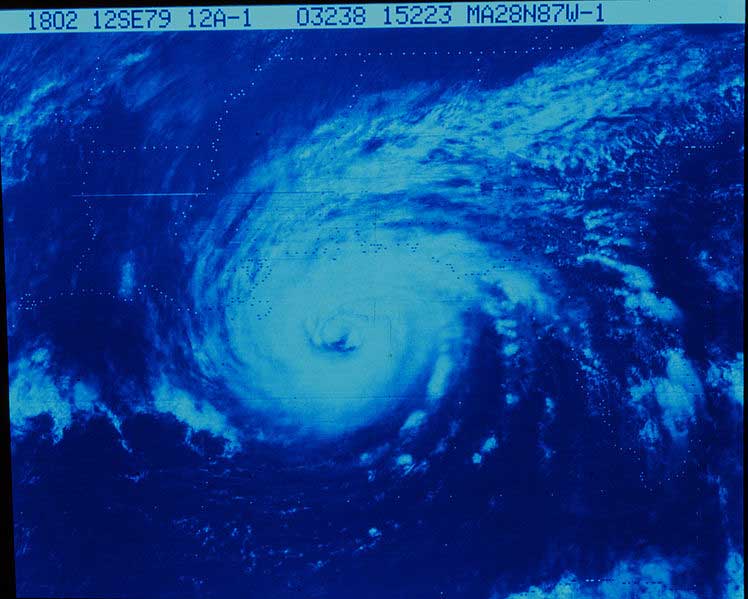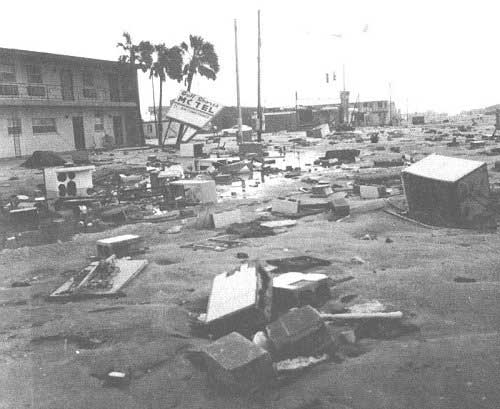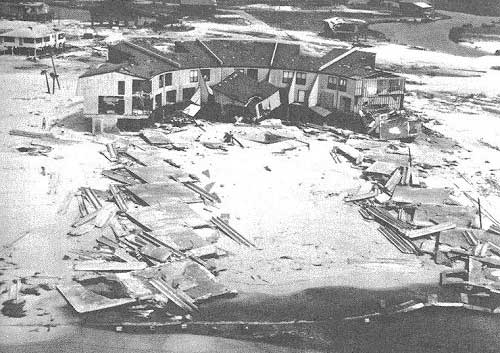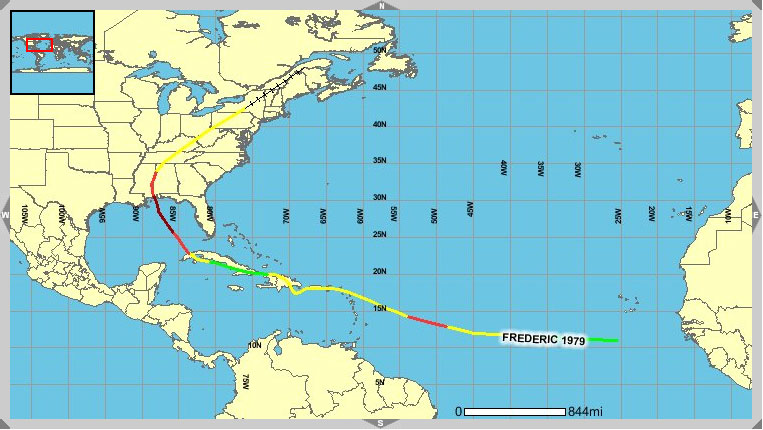30 Year Anniversary Of Hurricane Frederic
September 13, 2009
This weekend marked the 30th anniversary of the landfall on Hurricane Frederic along our portion of the Gulf Coast.
Frederic formed on August 29, 1979, as a tropical depression over the far eastern Atlantic, and became a hurricane on September 10 over the Gulf of Mexico. Frederic strengthened to a Category 4 hurricane over the Central Gulf with maximum sustained winds near 132 mph.
On Wednesday, September 12, 1979 at 5 a.m., the National Weather Service posted hurricane warnings from Panama City, Florida. west to Grand Isle, Louisiana. Frederic continued to strengthen, with highest winds estimated at 130 mph and central pressure of 28.05 inches of mercury. With a slightly increased forward speed at 12 mph, the hurricane continued moving northwest about 220 miles south of the Alabama coast.
 Hurricane Frederic was expected to produce a storm surge of 10 to 15 feet above normal in the area where the center made landfall. By 11 a.m. on September 12th, Frederic was located 175 miles south of Pensacola moving north-northwest at 12 to 15 mph. The diameter of the hurricane eye was reported to be about 10 miles. Reports from hurricane hunter reconnaissance aircraft and coastal weather radar networks indicated the eye of Frederic would cross the coast between Gulfport and Pensacola. Evacuation of the coast was nearing completion at that time. By 5 p.m., the center of Hurricane Frederic was about 80 miles south of Gulf Shores moving north at 15 mph.
Hurricane Frederic was expected to produce a storm surge of 10 to 15 feet above normal in the area where the center made landfall. By 11 a.m. on September 12th, Frederic was located 175 miles south of Pensacola moving north-northwest at 12 to 15 mph. The diameter of the hurricane eye was reported to be about 10 miles. Reports from hurricane hunter reconnaissance aircraft and coastal weather radar networks indicated the eye of Frederic would cross the coast between Gulfport and Pensacola. Evacuation of the coast was nearing completion at that time. By 5 p.m., the center of Hurricane Frederic was about 80 miles south of Gulf Shores moving north at 15 mph.
Conditions began to rapidly deteriorate during the afternoon of September 12th as Frederic made it’s final approach to the Alabama Gulf Coast. Hurricane Frederic approached the coast with a forward speed of 15 mph. The eye of the storm measured 50 miles in diameter east to west, and 40 miles north to south. In the opinion of some weather forecasters at the time, Frederic had the largest storm center they had ever recorded.
Shortly before 10 p.m. on the evening of September 12th, 1979, the northern eyewall of Frederic move ashore on Dauphin Island. As the eye struck land, it decreased in size to about 15 miles in diameter. The storm center crossed over the western end of Dauphin Island at 10 p.m. An automated wind gust recorder, located at the top of the Dauphin Island Bridge, recorded a peak wind gust of 145 mph. around 9:40 p.m.
 At landfall, Frederic was as strong category 3 on the Saffir Simpson hurricane intensity scale, raking the Mobile Bay area with winds gusting from 100 to 145 mph for several hours from the evening of September 12th until the early morning of September 13th. Hurricane wind gusts were experienced as far inland as Choctaw County Alabama during the early morning hours of September 13th.
At landfall, Frederic was as strong category 3 on the Saffir Simpson hurricane intensity scale, raking the Mobile Bay area with winds gusting from 100 to 145 mph for several hours from the evening of September 12th until the early morning of September 13th. Hurricane wind gusts were experienced as far inland as Choctaw County Alabama during the early morning hours of September 13th.
The damage cost from Frederic was $2.3 billion. Five deaths were directly attributable to the storm. A storm surge of 12 to 15 feet on the Gulf beaches and 8 to 10 feet on northern Mobile Bay destroyed numerous coastal buildings. Storm surge damage was documented for 80 miles along the coast.
The winds from Hurricane Frederic damaged or destroyed many homes and businesses. Many homes and businesses well inland suffered severe damage when large pine trees fell onto them or their roof structures failed. Along with peak wind gusts of 145 mph at the Dauphin Island Bridge, wind gusts of 97 mph from the east were recorded at Mobile Regional Airport. At midnight, Mobile County Civil Defense reported measured wind gusts at 101 mph, along with massive damage in Mobile and surrounding areas. At midnight, wind gusts from the north at 98 mph were reported by Biloxi Civil Defense, with north winds gusting to 115 mph at Ingalls Shipbuilding in Pascagoula.
On Thursday, at 2 a.m., the National Weather Service issued an intermediate advisory reporting the center of Hurricane Frederic had passed just west of Mobile and the hurricane force winds began to slowly subside in Mobile as Frederic continued to move north along the Alabama/Mississippi border. Extensive reports of damage in the Mobile metropolitan area were beginning to come in.
 After moving inland from the coast, the hurricane moved north and then northeast, increasing its forward speed to 23 mph. It did not lose hurricane intensity until it was in the vicinity of Meridian, Mississippi, at about 7:00 the following morning. By 8 a.m. September 13, Frederic was downgraded to a tropical storm. It maintained that intensity as it moved north through Mississippi, crossing back into Alabama west of Tuscaloosa. Late that Thursday afternoon, what had been Hurricane Frederic was further downgraded to a tropical depression as it moved north through Alabama.
After moving inland from the coast, the hurricane moved north and then northeast, increasing its forward speed to 23 mph. It did not lose hurricane intensity until it was in the vicinity of Meridian, Mississippi, at about 7:00 the following morning. By 8 a.m. September 13, Frederic was downgraded to a tropical storm. It maintained that intensity as it moved north through Mississippi, crossing back into Alabama west of Tuscaloosa. Late that Thursday afternoon, what had been Hurricane Frederic was further downgraded to a tropical depression as it moved north through Alabama.
Numerous large swaths of significant wind damage were documented in the days immediately following the landfall of Frederic. Fallen trees were a significant impact to residents, bringing down thousands of power lines and blocking roads for several days. Some areas of Mobile County experienced electric power outages for five weeks.
Over 500,000 people evacuated from the central Gulf Coast region ahead of Frederic, the largest evacuation along the Gulf Coast up to that time. Frederic was the first hurricane to strike Mobile directly since 1932. Before Frederic, the last hurricane with Category 3 winds to directly strike the Alabama Gulf Coast occurred in 1916.
Information and photos courtesy the National Weather Service.




Comments